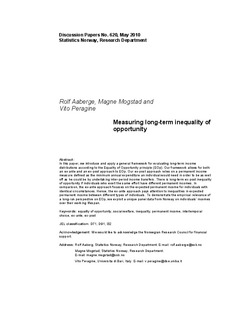| dc.contributor.author | Aaberge, Rolf | |
| dc.contributor.author | Mogstad, Magne | |
| dc.contributor.author | Peragine, Vito | |
| dc.date.accessioned | 2010-10-19T09:03:18Z | |
| dc.date.available | 2010-10-19T09:03:18Z | |
| dc.date.issued | 2010 | |
| dc.identifier.issn | 0809-733X | |
| dc.identifier.uri | http://hdl.handle.net/11250/179953 | |
| dc.description.abstract | Abstract:
In this paper, we introduce and apply a general framework for evaluating long-term income distributions according to the Equality of Opportunity principle (EOp). Our framework allows for both an ex-ante and an ex-post approach to EOp. Our ex-post approach relies on a permanent income measure defined as the minimum annual expenditure an individual would need in order to be as well off as he could be by undertaking inter-period income transfers. There is long-term ex-post inequality of opportunity if individuals who exert the same effort have different permanent incomes. In comparison, the ex-ante approach focuses on the expected permanent income for individuals with identical circumstances. Hence, the ex-ante approach pays attention to inequalities in expected permanent income between different types of individuals. To demonstrate the empirical relevance of a long-run perspective on EOp, we exploit a unique panel data from Norway on individuals’ incomes over their working lifespan.
KEYWORDS: Equality of opportunity, social welfare, inequality, permanent income, intertemporal choice, ex-ante, ex-post | en_US |
| dc.description.sponsorship | We wourld like to acknowledge the Norwegian Research Council for financial support. | en_US |
| dc.language.iso | eng | en_US |
| dc.publisher | Statistics Norway, Research Department | en_US |
| dc.relation.ispartofseries | Discussion Papers;No. 620 | |
| dc.subject | Social welfare | en_US |
| dc.subject | Inequality | en_US |
| dc.subject | Permanent income | en_US |
| dc.subject | Inntektsforskjeller | en_US |
| dc.subject | Sosial velferd | en_US |
| dc.subject | JEL classification: D71 | en_US |
| dc.subject | JEL classification: D91 | en_US |
| dc.subject | JEL classification: I32 | en_US |
| dc.subject | Fattigdom | en_US |
| dc.title | Measuring long-term inequality of opportunity | en_US |
| dc.type | Working paper | en_US |
| dc.subject.nsi | VDP::Mathematics and natural science: 400::Mathematics: 410::Statistics: 412 | en_US |
| dc.subject.nsi | VDP::Social science: 200::Economics: 210::Econometrics: 214 | en_US |
| dc.source.pagenumber | 31 s. | en_US |
